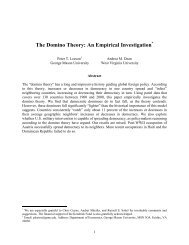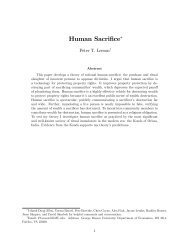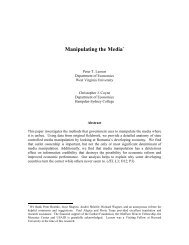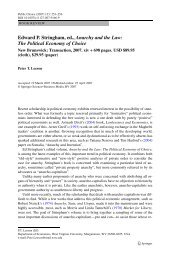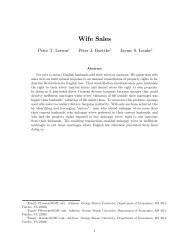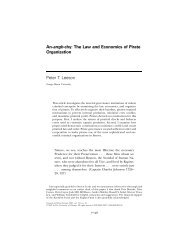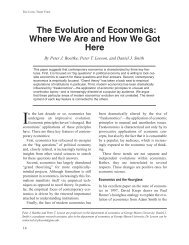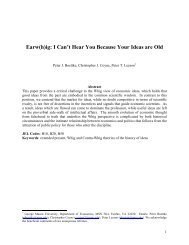The Democratic Domino Theory: An Empirical Investigation
The Democratic Domino Theory: An Empirical Investigation
The Democratic Domino Theory: An Empirical Investigation
Create successful ePaper yourself
Turn your PDF publications into a flip-book with our unique Google optimized e-Paper software.
536 PETER T. LEESON AND ANDREA M. DEAN<br />
with a migration-style mechanism along the lines discussed<br />
above. Democracy advocates in one country, for<br />
example, may penetrate the borders of neighboring countries<br />
that are less democratic, carrying their ideas with<br />
them as well as providing the impetus for domestic<br />
prodemocratic reform.<br />
A third potential channel of democracy’s geographic<br />
spread is through economic communities or zones. As<br />
Pevehouse (2002a, 2002b) points out, economic communities<br />
such as NAFTA and the EU often harmonize<br />
not only their members’ economic policies, but also their<br />
members’ political arrangements, in some cases requiring<br />
members to satisfy certain institutional requirements<br />
as a condition of membership. In many cases admission<br />
to these communities confers benefits on members in the<br />
form of cross-country subsidization, protection alliances,<br />
and so forth. <strong>The</strong>se benefits raise the value of joining<br />
economic zones, creating an incentive for nonmember<br />
nations to increase their level of democracy if, for example,<br />
membership requires institutional constraints that<br />
directly or indirectly serve to limit the executive’s authority.<br />
Since economic communities are often geographically<br />
based, their presence may in this way produce spreading<br />
democracy throughout a region of neighboring countries.<br />
<strong>The</strong> final potential mechanism of democratic contagion<br />
that Simmons, Dobbin, and Garrett highlight is<br />
what they call “emulation.” According to this idea, some<br />
“big player” countries, such as the United States, lead<br />
in terms of political institutions (and policies), which<br />
other countries then follow. If the United States strengthens<br />
its democracy in some fashion, other countries may<br />
do so as well. Like the other channels considered above,<br />
this channel need not be a geographic mechanism of<br />
spreading democracy. If, for instance, Argentina follows<br />
prodemocracy reform in the United States, democracy<br />
may spread but not between geographic neighbors. However,<br />
within various geographic regions there may be local<br />
“big players”—regional leader countries—that neighboring<br />
nations tend to look to in guiding their behavior. In<br />
this way emulation may also be a geographic channel for<br />
democratic dominoes between neighboring countries.<br />
<strong>The</strong>se are only a few of the imaginable mechanisms<br />
through which democratic dominoes might be set in motion.<br />
Surely others could be proposed. Further, while in<br />
principle some of these channels, such as emulation, may<br />
be capable of spreading either increases or decreases in<br />
democracy geographically, others, such as Tiebout competition,<br />
may only be capable of spreading increases in<br />
democracy geographically. Although these channels are<br />
conceptually distinct, separating them empirically is a<br />
different matter. Our interest is in identifying if there is<br />
in fact any significant empirical evidence for democratic<br />
dominoes regardless of their source and, if there is, establishing<br />
how “hard” they fall. It is not our goal, nor<br />
does our empirical strategy allow us, to identify which, if<br />
any, of the specific potential channels of democracy’s geographic<br />
spread have or have not been at work at various<br />
points in history. Although it does not do so in a spatial<br />
econometric framework and is not focused only on<br />
democracy, some existing research has found evidence for<br />
various kinds of “policy diffusion” via each of the channels<br />
pointed to above (see, for instance, Elkins, Guzman,<br />
and Simmons 2006; Gleditsch and Ward 2006; Lee and<br />
Strang 2006; Swank 2006). Future work should attempt to<br />
pinpoint the operation of these and other specific mechanisms<br />
explicitly in the context of the spatial framework<br />
this article employs.<br />
Data and <strong>Empirical</strong> Strategy<br />
Our basic empirical strategy, discussed in detail below, follows<br />
Leeson and Sobel (2007), who investigate “capitalist<br />
contagion” between neighboring countries. We search for<br />
spatial dependence in changes in democracy across geographic<br />
neighbors over time. To do this we construct a<br />
panel of democracy scores for four different time periods:<br />
1851–2001, 1901–2001, 1951–2001, and 1991–2001.<br />
We want to take advantage of the fact that international<br />
democracy scores are available going back to the start of<br />
the nineteenth century. However, the further back our<br />
sample goes the fewer countries it contains. Although<br />
democracy data extend back to 1800, they are only available<br />
for seven countries we can use and none of these<br />
countriesaregeographicneighbors.Thispreventsusfrom<br />
constructing a spatial weight matrix to estimate democracy’s<br />
spread between them. However, the data do permit<br />
us to consider a panel that extends back to 1850, which<br />
consequently constitutes our longest sample.<br />
Considering four different samples that cover different<br />
time periods allows us to maximize the number of<br />
years and number of countries our analysis considers. It<br />
also allows us to see if the process of democratic contagion<br />
described by the democratic domino theory may<br />
have been at work during certain periods but not others.<br />
Appendix A lists all of the countries in each of our<br />
samples. Each sample contains only those countries that<br />
exist from the first year of the sample under consideration<br />
until the last year in the sample. For example, a country<br />
that only came into being in, say, 1920, would not be<br />
included in the 1901–2001 sample. This is why our 1901–<br />
2001 sample, for instance, has fewer observations than<br />
our 1951–2001 sample. To generate spatial estimates, the



